URBAN
Detailed category
Residential areas and housing complexes (mainly detached houses)
2Residential areas and housing complexes (mainly apartment buildings)
3Urban areas in the center of big(citiesoffice districts, business buildings)
4Urban areas in the center of big(shopping districts, commercial facilities)
5Satellites
6Hydrogen stations
7City parks / Green spaces
8Roads
9Convenience store


Molding material MAPKA® that contains 51% paper powder and can halve plastics
The only one molding material in the world contains paper powder born in Japan.
Cuts the plastic halves and CO2 by 43%.

1:Tableware(Injection molding)
2:Tray(Sheeting / Vacuum forming)

3:Paper powder and PLA, PBS(Injection molding / blow molding)Spoon and Fork(Injection molding)
4:Air conditioner fan casing(Injection molding)
Reducing the amount of plastic that imposes a burdem on the global environment is a universal thema.
In recent years, paper products and bioplastic products have begun to be used as altermatives to plastics, but It has not reached the level of "convenient, cheap and high-performance" plastic products, and has not grown significantly.
Despite the fact that MAPKA contains 51% of paper powder, which is a biomass, it has almost the same functionality as plastic products and can be molded using plastic molding technology, so it has steadily increased its market share.
In addition, recycling grades have already been commercialized because they can be remolded by crushing and repelling them in the same way as plastics.
Display the document


Cup Noodle: Continuing to evolve with the times. For the earth. For the future.
Fifty years on, Cup Noodle still aims not only for great taste but also to solve environmental and social issues.

As an EARTH FOOD CREATOR imagining new kinds of food culture, the Nissin Food Group aims to solve environmental and social issues. As our signature brand, Cup Noodle has been constantly evolving since its creation in Japan in 1971 as the world's first cup noodle brand. Today, we deliver small but delicious products to consumers, packed with technologies and ideas to solve environmental and social issues, including the use of 80%+ biomass containers, plant-based meat technologies, and sustainable procurement of palm oil. Under the EARTH FOOD CHALLENGE 2030 environmental strategy, we will continue to make effective use of resources and actively tackle environmental issues, aiming to achieve SBT-certified CO2 reduction targets (Scope 1+2: -30% comp. 2018, Scope 3: -15% comp. 2018).
Display the document

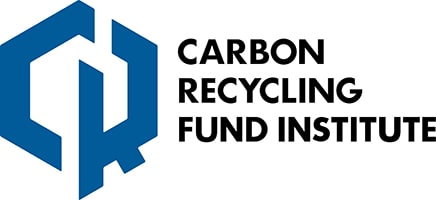
Creating “Sustainable Carbon Society” by CO2 Utilization and Carbon Recycling
We achieve a virtuous cycle of the environment and economy through promoting carbon recycling and creating innovation.
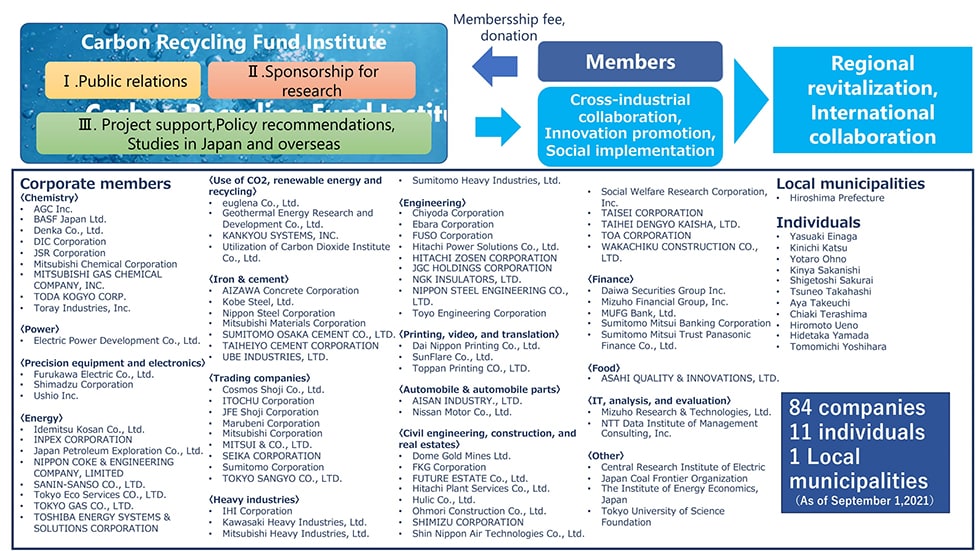
Business scheme and member list
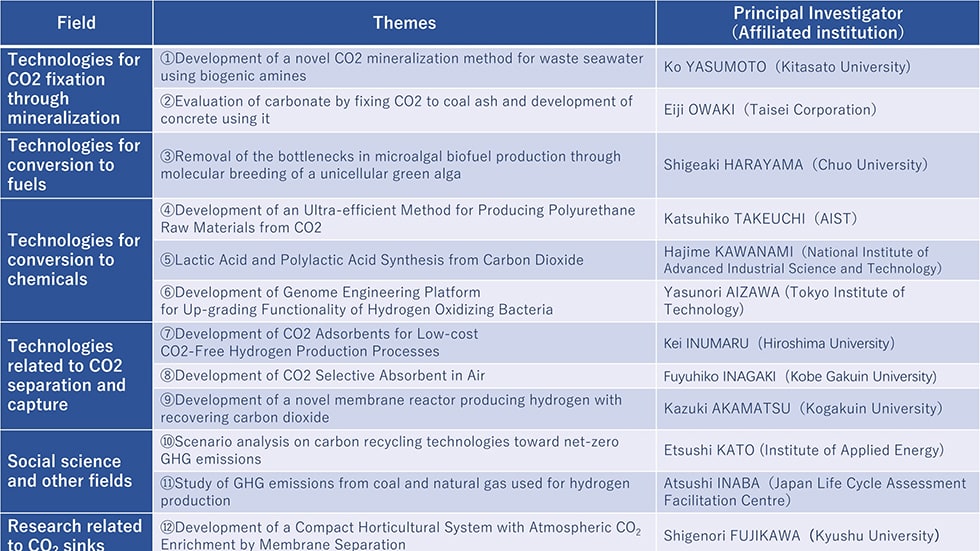
A list of studies adopted in 2021
Aiming simultaneously to solve problems with global warming and energy access, we support the activities of various companies and individuals working on implementation of carbon recycling with membership fees and donations from our members as the source.
We provide public relations, grants to researchers, support for members' business, and policy recommendations on carbon recycling.
Members are composed of a wide range of industries such as chemistry, energy, construction, finance, and trading companies. Taking advantage of the characteristics of cross-industry organizations, we strive to promote open innovation and contribute to regional revitalization and international cooperation.
The research grant activities support basic research with excellent originality and innovation in carbon recycling by uncovering ideas and researchers buried in companies, universities and other organizations, and also support applications for national projects and social implementation as the next step.
Display the document


Redesign the economy and society using hydrogen towards the realization of carbon neutrality.
Use of hydrogen fuel cells are the most suitable solution towards the realization of societies where decentralized energy systems are available.

HARUMI FLAG : Japan’s first full-scale hydrogen infrastructure(original Tokyo2020 Village area)
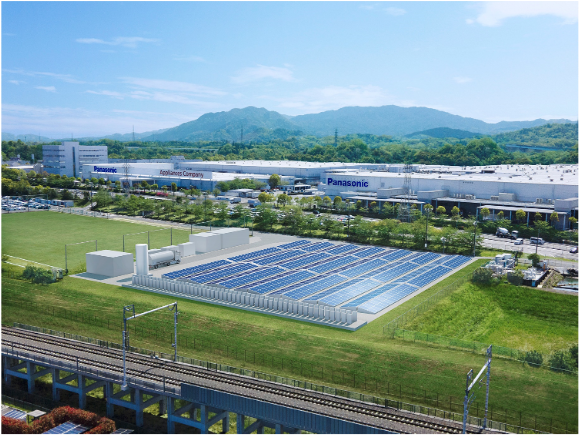
First hydrogen-based plant using only renewable(RE100 solution)
Utilization of renewable energy is a key towards the realization of carbon neutrality. Yet, a means for storing energy to adjust energy supply is required as renewable energies are unstable power source. Thus, we have exhibited a system that can respond to energy demands ranging from a small to a large scale supply using fuel cells where hydrogen is utilized.
We introduce various methods for utilizing hydrogen in our exhibition with Diorama;
1) supply of hydrogen to buildings and housing area through pipelines,
2) transportation of hydrogen to high demand areas for storage and utilization of the stored hydrogen,
3) utilization of the hydrogen generated from chemical factories, etc. as a by-product,
4) decentralized power source; electricity is generated from renewable energies and hydrogen is generated from the electricity for its utilization.
Display the document

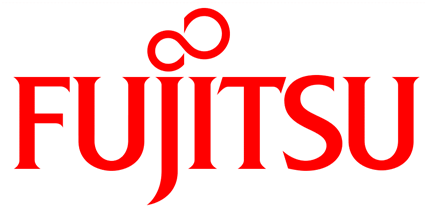
Energy-saving solution with high-efficiency GaN device
Challenge to save energy in the digital society with highly efficient GaN high electron mobility transistors!
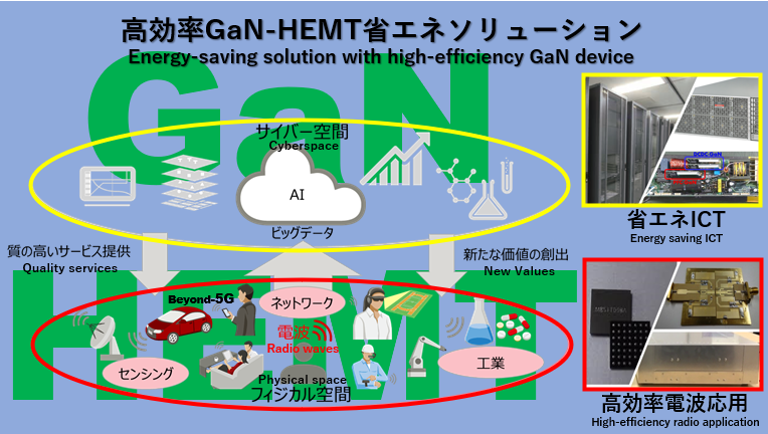
Introducing an energy-saving solution using high-efficiency GaN-HEMT (gallium nitride high electron mobility transistor), which is being developed by participating in a project of the Ministry of the Environment.The newly developed GaN-HEMT can save energy by suppressing unnecessary heat generation of electronic devices. For example, we will realize various energy-saving solutions that reduce the power consumption of equipment that supports society and daily life, such as server equipment used in offices and data centers, microwave heating equipment (microwave ovens) used in homes and chemical plants. This technology will contribute to the reduction of GHG emissions while supporting the digital society of the future, and will make the world more sustainable.
Display the document


Hitachi is Becoming a Climate Change Innovator to Realize a Decarbonized Society
Hitachi is a Principal Partner of COP26 to show strong commitment to the realization of global efforts to decarbonize.
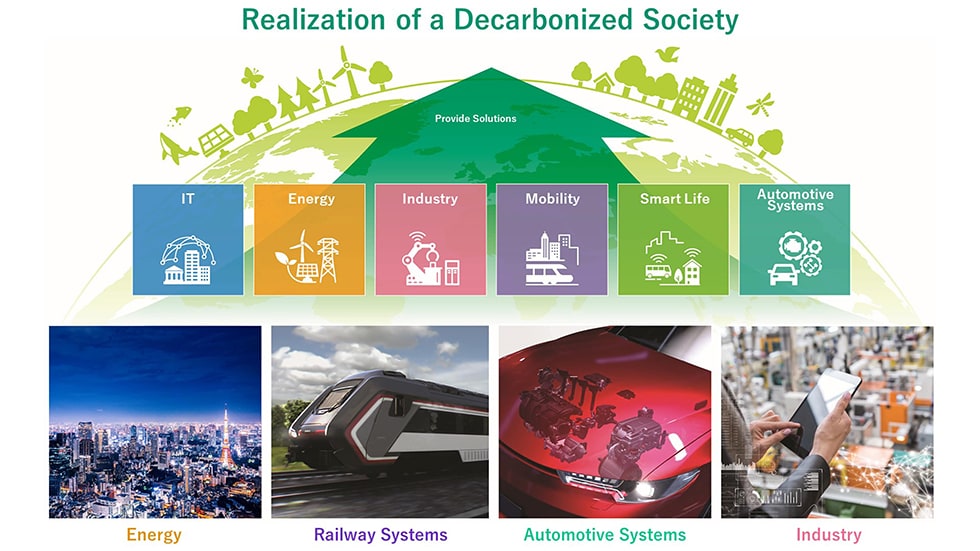
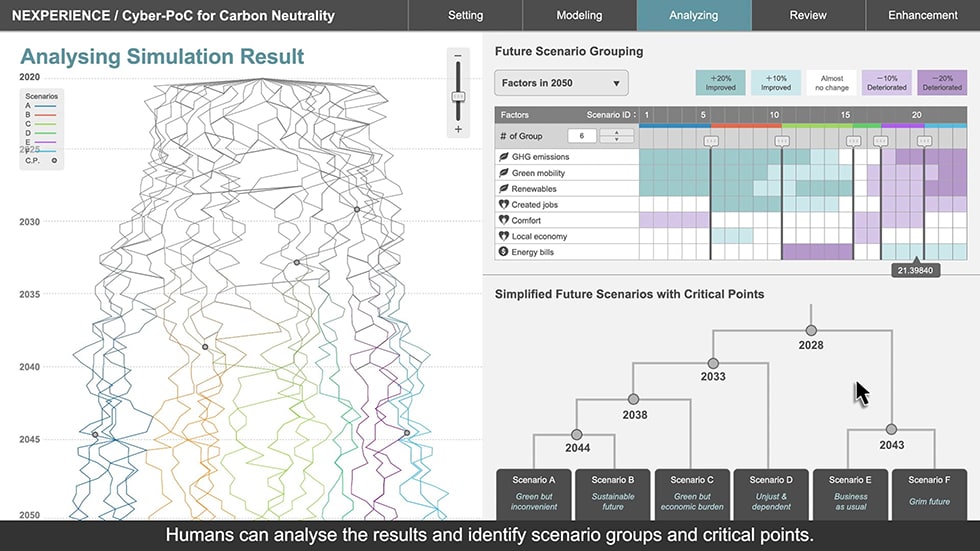
Future scenarios and critical points simulated by AI based on various parameters
Hitachi strives to improve people's quality of life and contributes to achieving a sustainable society through the Social Innovation Business that creates new value for society by offering a combination of the OT (operational technology), IT and products.
We are accelerating our efforts to achieve carbon neutrality within Hitachi by FY2030 and across the company's entire value chain by FY2050. Hitachi's green technologies and digital innovations help governments, cities and companies cut their greenhouse gas emissions, and contribute to solving challenges in the area of climate change.
In addition, we work on the development of AI simulator showing future scenarios and critical points to promote fruitful discussion on future policy roadmap among various stakeholders for carbon neutrality.
Display the document


Resource Aggregation for Decarbonization “Net-Zero”
Contribute for renewable energy resource as main power supply with a solution to control Distributed Energy Resources
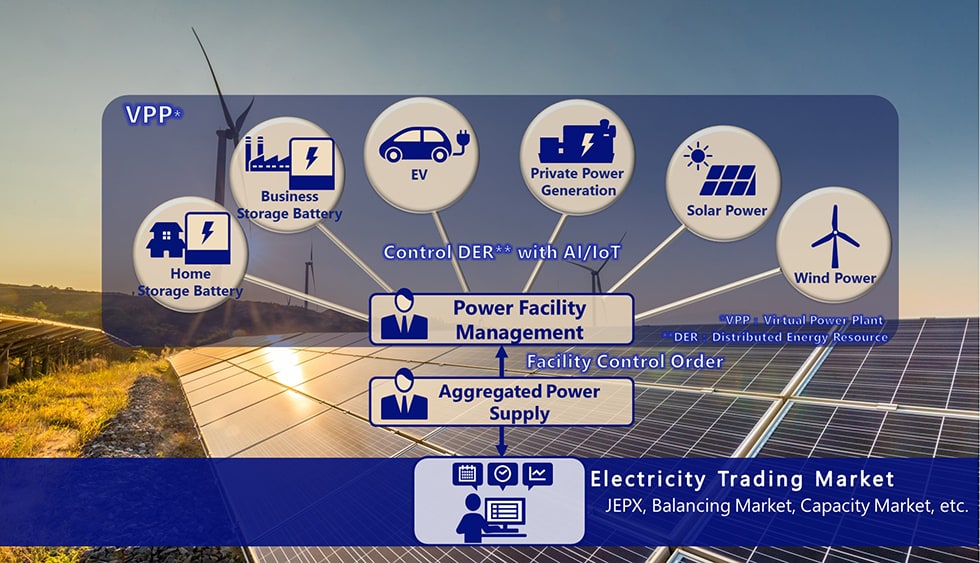
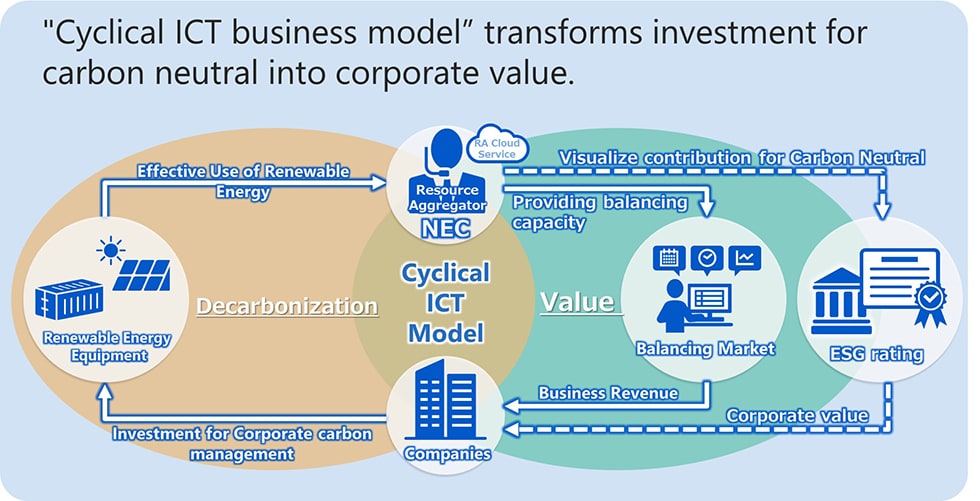
The Balancing Market in Japan was established in 2021 to deal with adjustment capability to balance the fluctuation of power supply and demand, and to maintain the frequency of electric power.The Balancing Market has a key role for renewable energy to be the main power supply.
Since the renewable energy is unstable power supply, balancing capability using AI/IOT to apply Demand Response (DR) on Distributed Energy Resource (DER) is necessary.
"NEC Energy Resource Aggregation (RA) Cloud Service" controls the power demand of DER remotely through VPP* to balance the supply and demand in market within the specific time, according to the DR order from Aggregation Coordinator (AC).
NEC contributes to the “carbon-free” society by reducing Co2 with Resource Aggregation.
*VPP: Virtual Power Plant
Display the document


RuleWatcher - Global rule trends visualizing for Climate mitigation
Translating and visualizing information from govs and orgs using AI. A platform to bring knowledge to everyone.
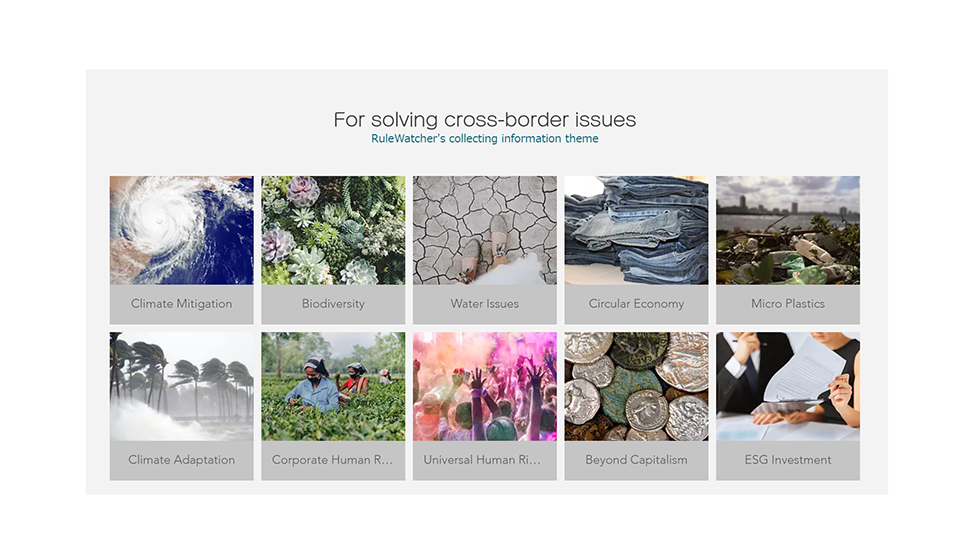
The rules monitored by RuleWatcher are groups of issues that cross national borders. We hope that you will make use of this information in your policy making, project planning, research and civic activities.
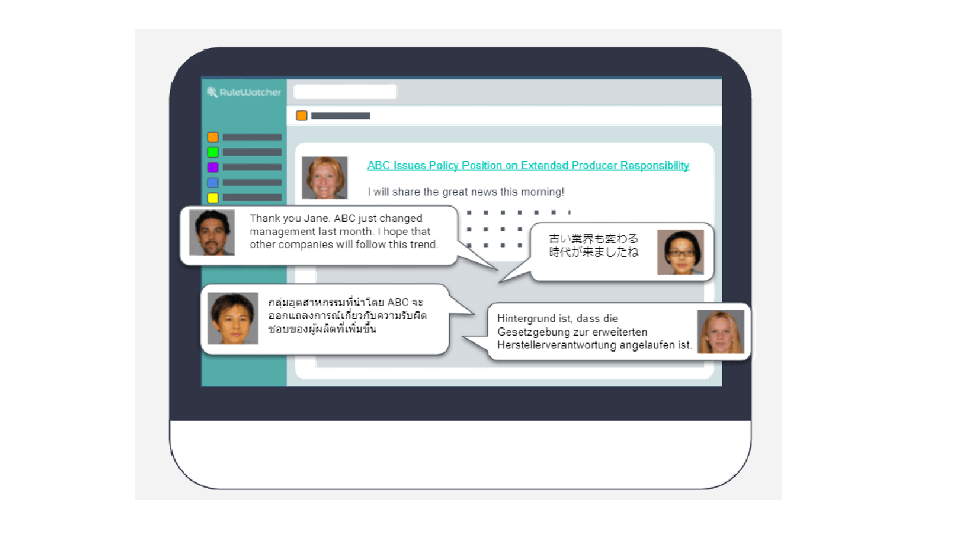
Bringing ideas from different countries to information on the same issue
RuleWatcher® automatically categorizes multilingual information (bills, minutes, press releases, policy recommendations, etc.) from all over the world. As it is Englished and visualised, we can easily grasp them from major parliaments, governments, UNs, research institutes, think tanks, international NGOs, initiatives, evaluation agencies, etc. RuleWatcher sorts them into themes such as "climate change mitigation" and "biodiversity protection" as well. It is a platform that brings together diverse knowledge from all over the world to provide accessible primary information to people around the world who want to solve global issues.
Display the document


New Solar Cells to Boost Renewable Energy
Light, film-type perovskite solar cells and Cu₂O tandem solar cells with high power generation efficiency
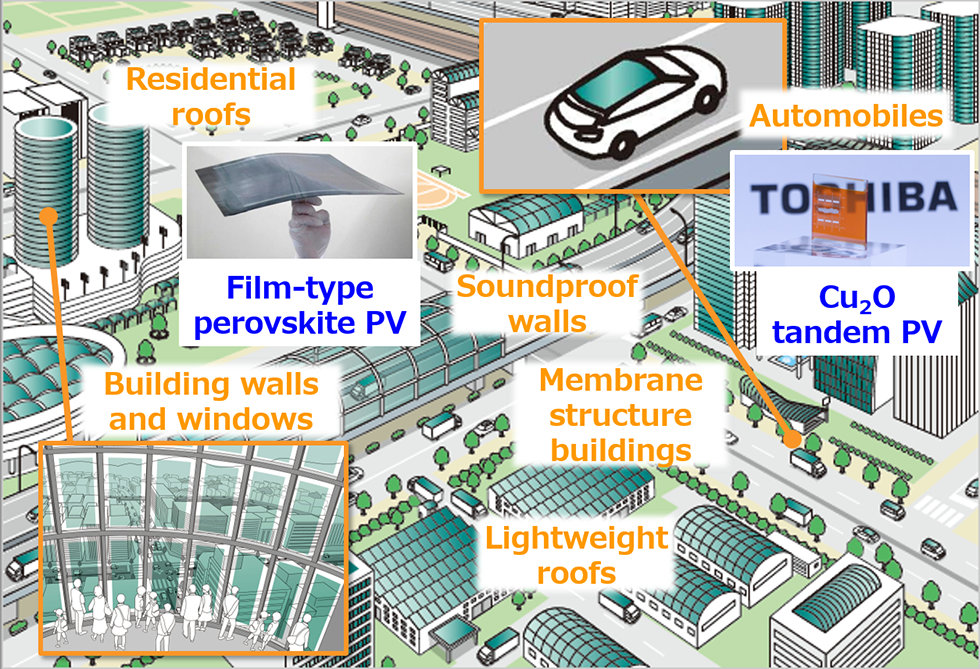
Perovskite cells and tandem cells meet different needs in urban areas
If we are to achieve carbon neutrality, we need to deploy more, and more efficient, photovoltaic power generation. However, current silicon (Si) solar cells are heavy and inflexible, which restricts where they can be installed, and there are limits to how far they can be improved. Two solar cells that Toshiba Group is developing will change this. Film-type perovskite solar cells are light, thin and flexible, and can be installed in buildings and locations inaccessible or unsuitable for Si cells. The Cu₂O tandem solar cell places a transparent copper oxide (Cu₂O) solar cell over a Si solar cell, boosting generation efficiency and producing much more power by area.
Display the document


HEMIX™ bioplastics utilizing wastes from agriculture, forestry and fisheries
We reduce CO2 emissions by creating bioplastics from unused or discarded materials such as trees and marine products.
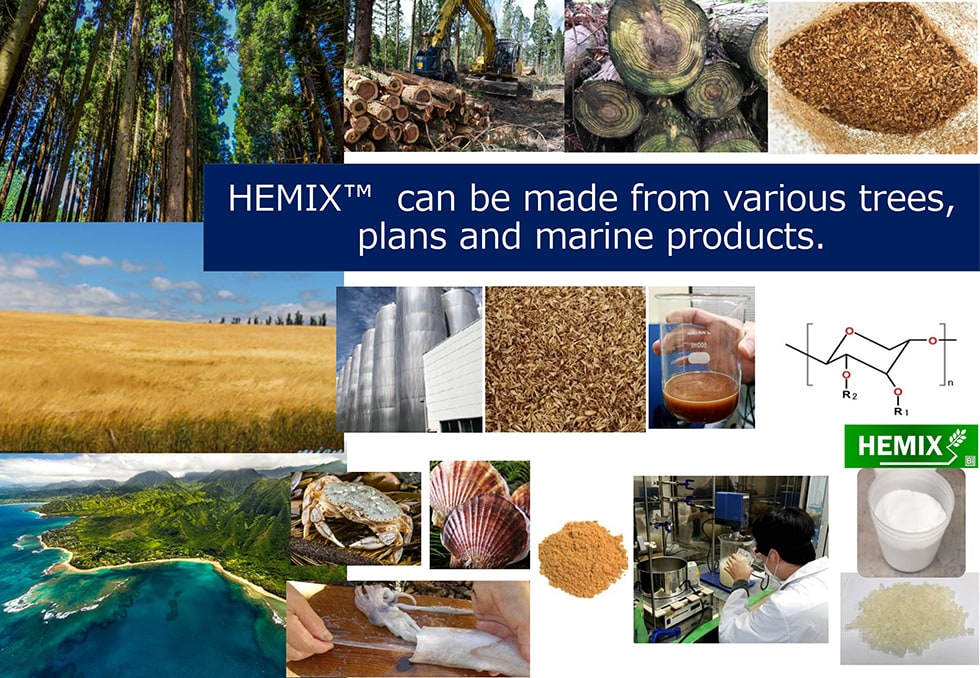
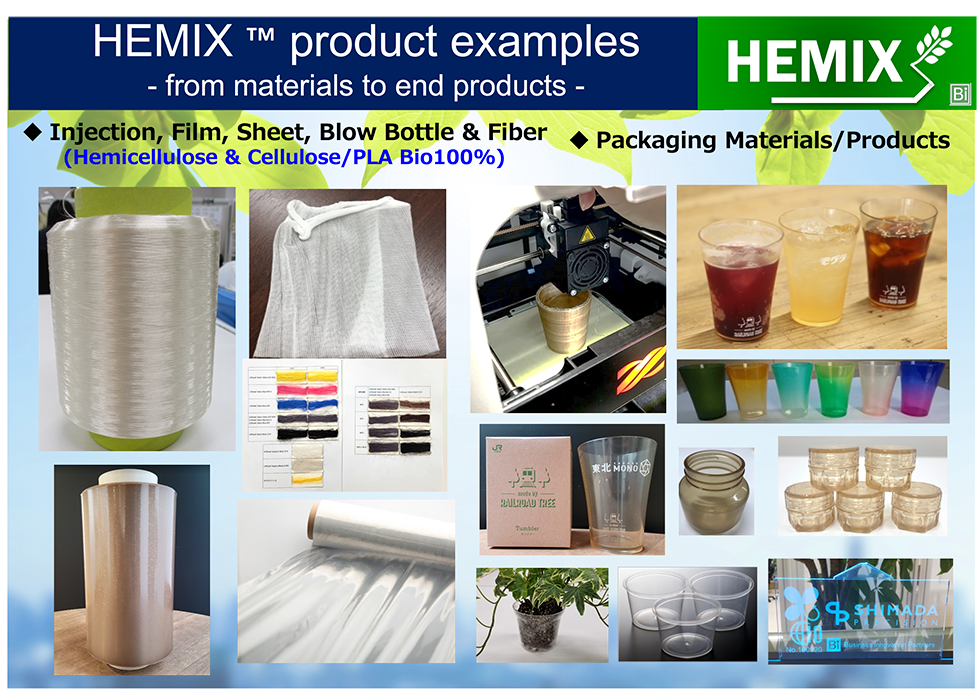
We are promoting the practical application of "HEMIX™, a biodegradable bioplastic developed using hemicellulose which is a component contained in trees and plants in general and has excellent biodegradability, liquidity and transparency, by making full use of our proprietary extraction, chemical synthesis, and mixing technologies.
Resin can be developed from cedar, hinoki cypress, barley, coffee grounds, tea leaves residuals, squirt, etc., in cooperation with various business entities in the agriculture, forestry and fishery industries that aim to utilize trees, plants, and marine products that have not been used, discarded or incinerated.
This is a technological development that contributes to the reduction of CO2 emissions toward the realization of a zero-carbon society by 2050.
Display the document


Chemical recycling technology enabling a circular economy of plastic waste
JGC provides 3 chemical recycling technologies: Monomerization, Pyrolysis, and Gasification, accommodating the plastic waste impurities.
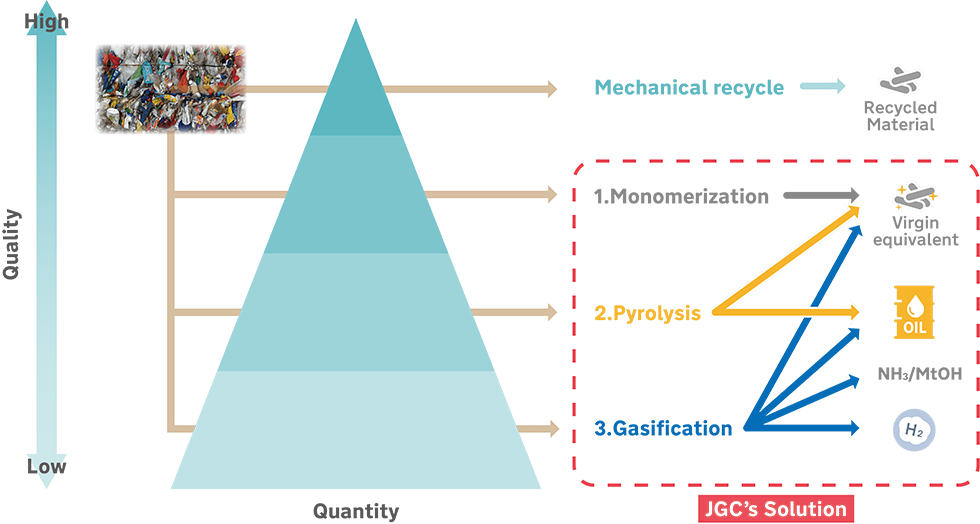
Technology line-up for plastic waste recycling

Total solution for plastic in a circular economy
Monomerization: The DMT method has an advantage in removing dyes and impurities in raw materials. It is an effective method to recycle clothing polyester and cascade recycled PET products that are not suitable for material recycling. The method has an operation track record on a commercial scale and solves the mass clothing waste issue.
Pyrolysis: A technology based on Japan's largest commercial pyrolysis equipment using a catalytic pyrolysis method. Pyrolysis oil is supplied to refineries and chemical plants to realize chemical recycling. It also enables the processing of PVC / PET mixed plastic.
Gasification: EUP gasifies plastic waste by partial oxidation to produce syngas that can be used to synthesize chemicals such as ammonia and olefins. It holds the world's only long-term commercial operation record for gasification chemical recycling applications.
Display the document

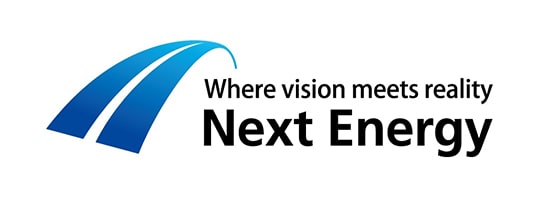
Expansion of renewable energy&Circular Economy through self-consumption PV System
The key for expanding renewable energy! Introduction of related products&services for self-consumption PV system
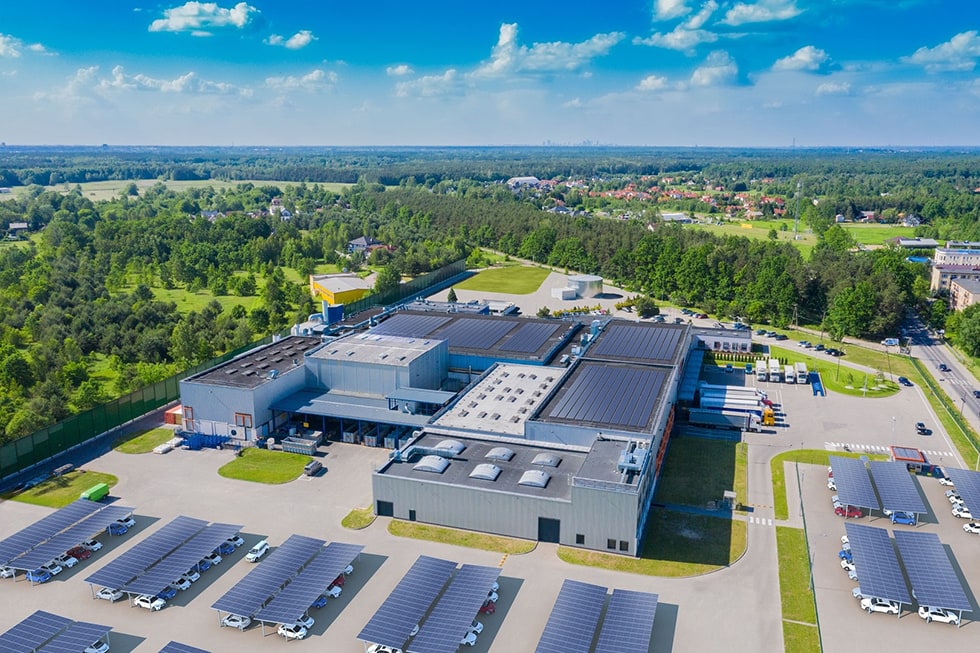
Image of solar power generation equipment installed on roofs and in parking spaces
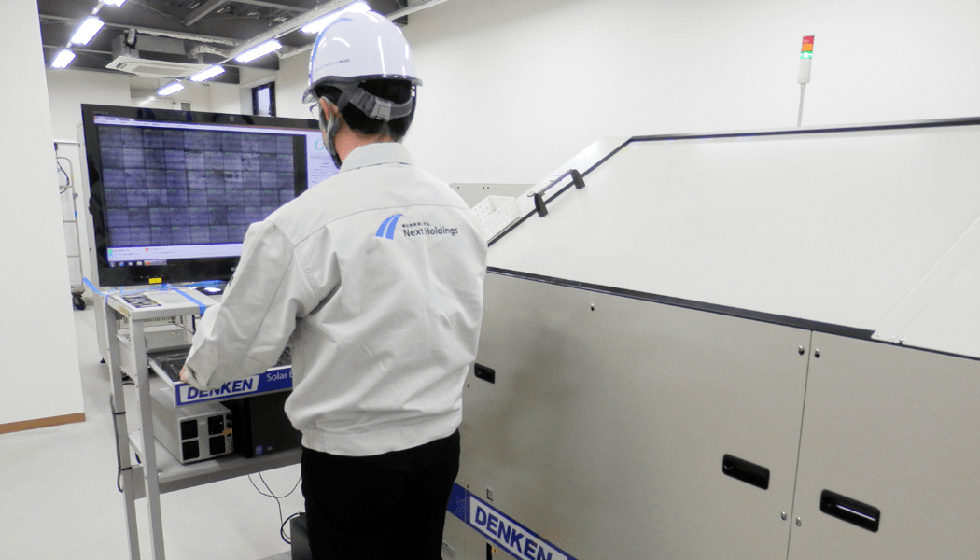
Inspection of used solar modules(By visualizing the infrared light emitted from the cells when current is passed through the solar cell module, cracks in the cells and wiring abnormalities can be checked.)
We believe "self-consumption PV system" is the most effective way to resolve climate change which enables the rapid implementation of renewable energy. The self-consumption PV system stands for self-production and self-consumption of electricity by installing PV system at residence or at the company's facilities for using the generated electricity by themselves.
We are actively developing products and services for self-consumption PV system focusing on “Competitive”, “Rapid”, “Bulky” and “Flexible”.
Since 2005, we have considered mass disposal of PV modules as an issue, and offering solution.By using our knowledge and data gained through inspection of used modules exceeding 140,000 units, we are working for establishing appropriate recycling product cycle.
Display the document

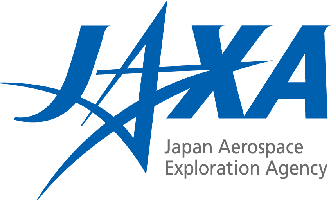
JAXA's effort on Climate Change monitoring by Satellites
JAXA is operating satellites and enhancing Earth observation research for contributing to tackling Climate Change.
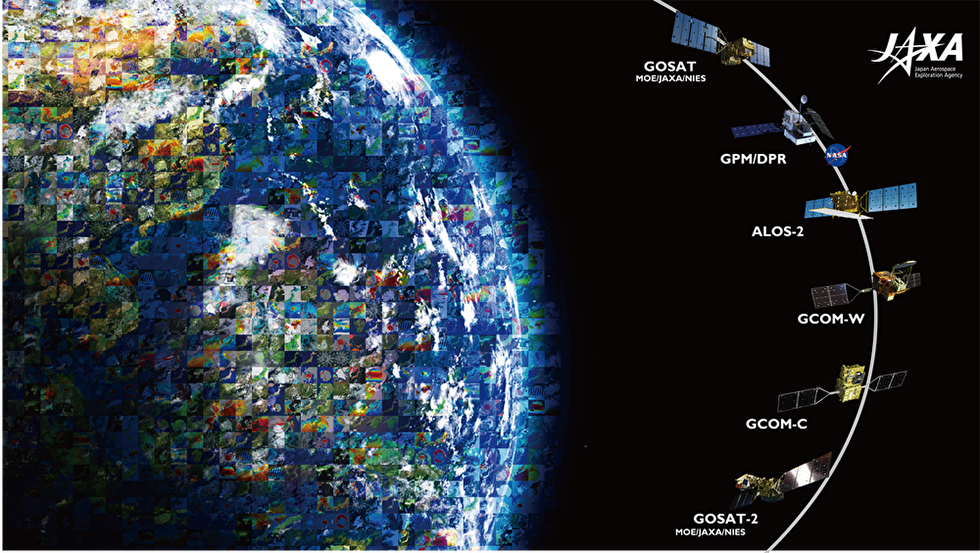
Figure1. Japanese Earth Observation satellites in Operation
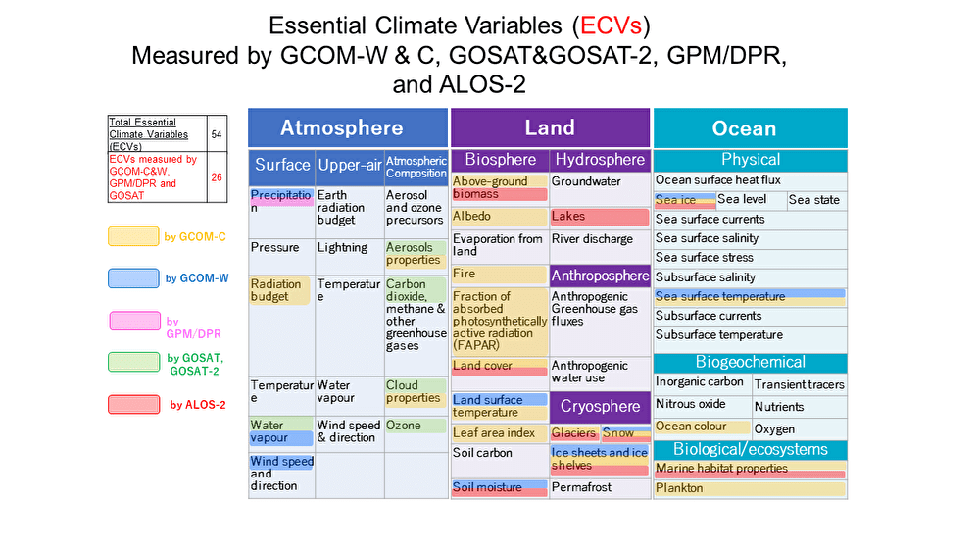
Figure 2: Contribution of JAXA’s Earth Observation Satellites to GCOS ECVs
JAXA, the Japanese core agency to develop satellites, is operating 6 satellites and developing various earth observation satellites that observe land, ocean and atmosphere for addressing the global challenges.
The data are publicized with free and open access to enhance people around the world to utilize those for various purposes. To understand the status of climate change, it is necessary to observe effective geophysical parameters globally with optimal spatial and timescales. Essential Climate Variables(ECVs) were specified internationally to identify and predict specific changes in the global environment caused by climate change. Currently, JAXA’s Earth observation satellites contribute to 26 ECVs, and the long-term satellite observation data is used in several reports including IPCC.


Innovative Peatland Management by Ground Monitoring and Earth Observation with AI
Maximizing the natural capital of tropical peatlands through scientific knowledge & technologies to tackle climate changes
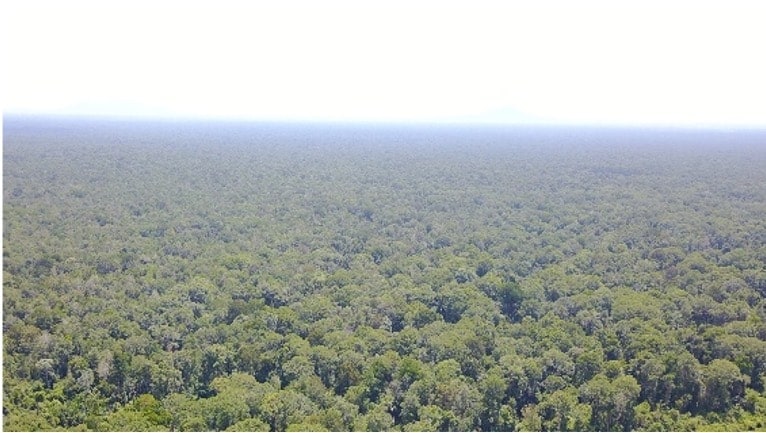
Protected tropical peatlands in Indonesia under Sumitomo Forestry management
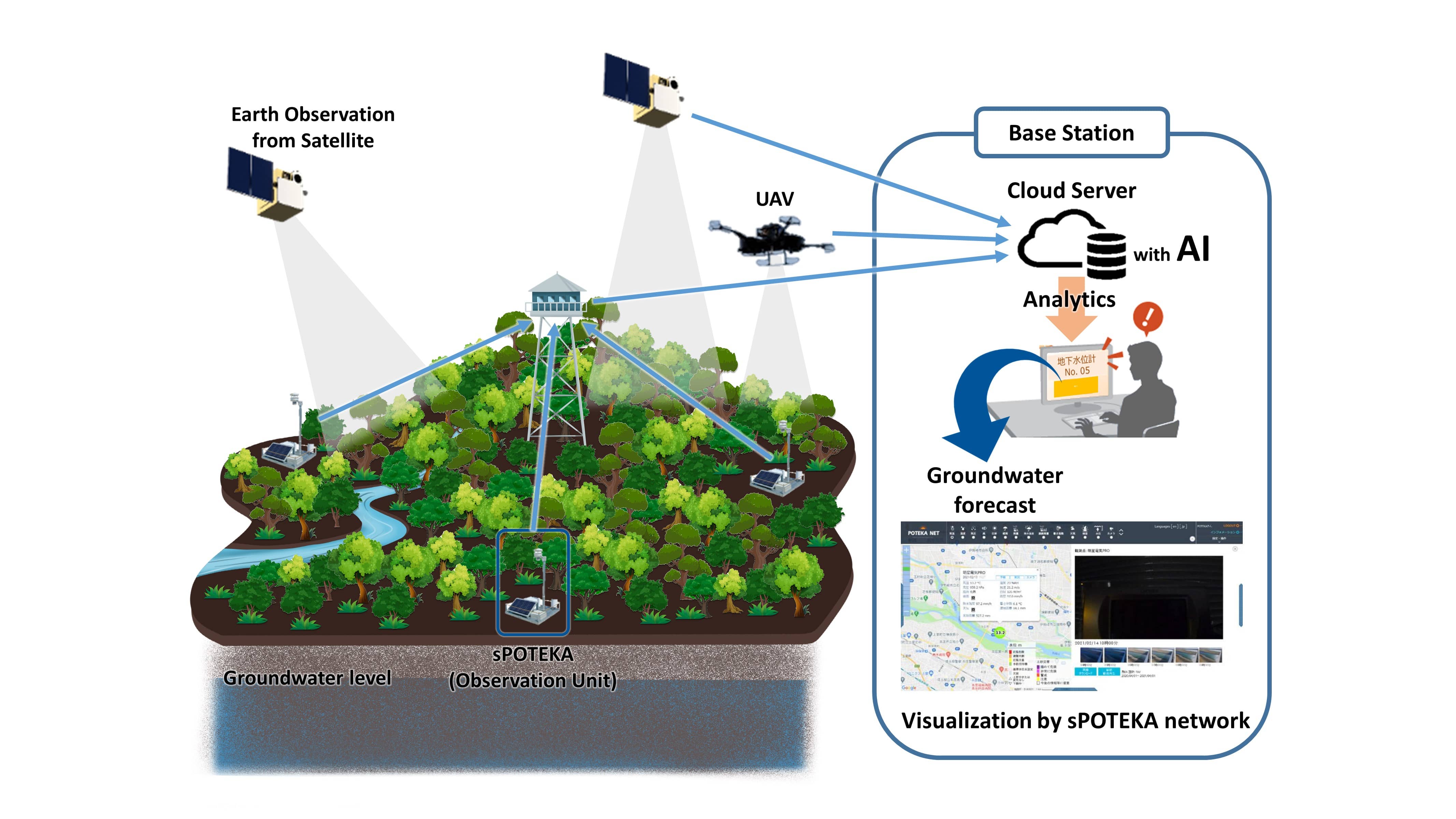
Monitoring concept by weather and earth observation technologies
Tropical peatlands store vast amount of carbon and sustain global water cycle and biodiversity. However, overexploitation/fires have released 2.2 to 3.7 billion t-CO2/yr. This is equivalent to 6 to 11% of global emissions. Sumitomo Forestry (SFC) has realized sustainable forestry in Indonesia based on scientific knowledge; developed a management model preventing peatland from drying out and collected data over 10 years. SFC and IHI have teamed up to bring this sustainable model to the world, which tackle global climate changes by monitoring on ground and earth observation with AI. Ministry of Economy, Trade and Industry (METI) supports our development through promoting utilization of satellite data, such as HISUI, ASTER, PALSAR. We are planning to launch constellation of satellites in equatorial orbit to improve these observation technologies.
Display the document


AMUSE™️ for the Hydrogen Society
The Potential of Ammonia as a Hydrogen Carrier
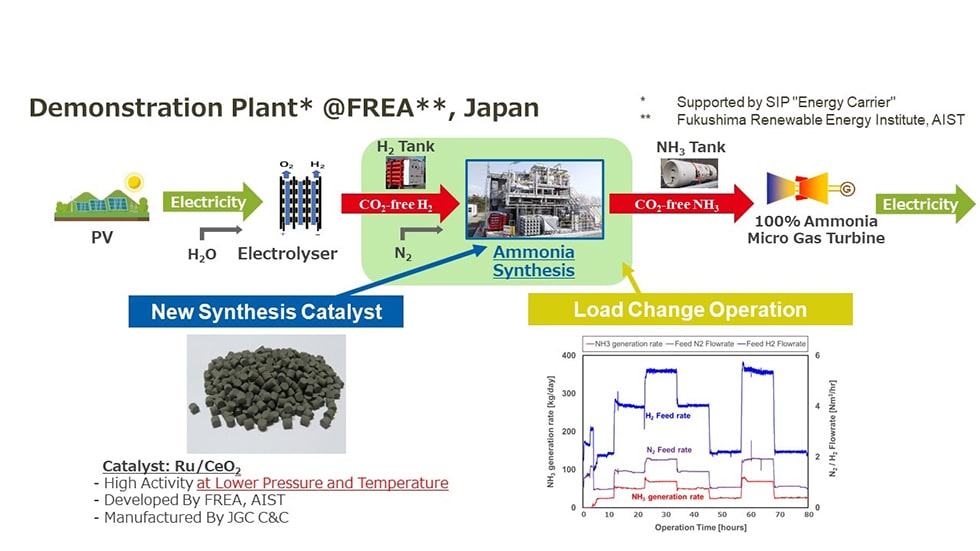
Green Ammonia Value Chain Demonstration
A value chain demonstration that achieved green ammonia production using green hydrogen derived from renewable energy sources (PV) and CO₂-free power generation by ammonia gas turbine.
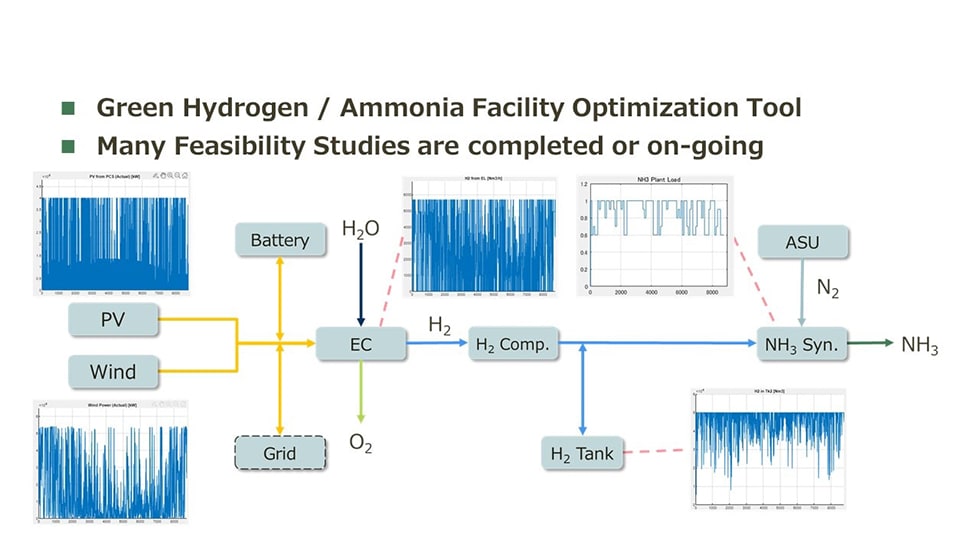
Development of the Green Hydrogen and Ammonia Facility Optimization Tool
Appropriate capacity design is required to accommodate the constantly fluctuating renewable energy. We have developed a plant design optimization tool for renewable energy showing various generation profiles based on the location, season, and type.
As a solution to realize a decarbonized society, the use of hydrogen energy is expected to expand in the future. The JGC Group is capable of handling all three major hydrogen carriers (liquefied hydrogen, liquid organic hydrides, and ammonia) that are expected to be widely used in the future, and particularly has expertise in the use of ammonia as a hydrogen carrier and fuel. We are developing our original solution AMUSE™️, bringing together the technologies from inside and outside of the company, and aiming for the early realization of a hydrogen society.
At this exhibition, we will introduce the world's first successful demonstration project of a green ammonia value chain and the development of the optimal configuration tool that responds to fluctuations in renewable energy.
Display the document


Hydrogen Gas Turbine Technologies Paving the way towards carbon neutral society.
Large scale utilization of hydrogen by gas turbines will help develop the hydrogen economy and reduce CO₂ emissions
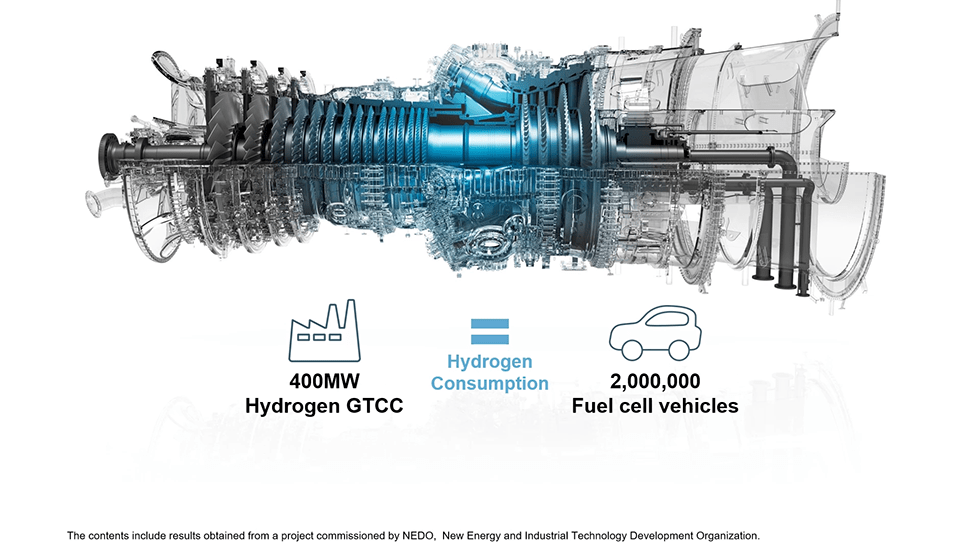
Hydrogen gas turbine illustration and a comparison of hydrogen consumption.

Illustrative picture of Zero Carbon Humber / H2H Saltend Project
Mitsubishi Power, a power solutions brand of MHI is developing hydrogen gas turbine technology based on its world-leading efficient large frame gas turbine techonology.
With 50 years experience in thermal generation, we have achieved 30% H₂ co-firing with dry low NOx gas turbines using coventional combustion systems.
A new combustion system for 100% H₂ firing is currently under development and will be completed in the near future. The system will overcome H₂ specific issues (such as its fast combustion characteristics) and can be applied to existing facilities with minimum modifications.
In the UK, we are involved in the Zero Carbon Humber Project which aims to decarbonise the Humber industrial region, where a feasiblity study for the conversion of our GTCC to H₂ firing at Triton Power Plant is currently underway.
Display the document


Let's Origami, Comolevi Shade! Cooling your cities!
An activity to make an artificial canopy and cool a hot city. As an origami shading paper that anyone can cool, it cools heated cities with climate change.

The side and plan view of Origami Comolevi Shade

Origami Comolevi Shade for Market space in Pandemic situation.
Tree shade is a nature-based solution for climate change that effectively cools hot cities. However, due to the high density of the urban environment, street trees with narrow canopy do not provide enough shade.
By 2030, when 70% of the world will be urban, the urban heat island will be promoted by climate change, further increasing the risk of heatstroke.
The hybrid nature-based solution must plant trees and invent artificial tree shading for cooling cities worldwide before urbanization comes.
Comolevi Origami Shade is a tree-like cooling shade, and anyone can use origami to make the shade.
Just cut and fold the paper, and anyone in the world can create tree shade. It is possible to take measures against the heat that no one leaves behind with a nature-oriented sunshade.
Display the document


Strategy towards sustainable and zero-carbon society in developing countries
JICA's climate change strategy focuses on Implementation of the Paris Agreement & Actions for Development Co-Benefits.
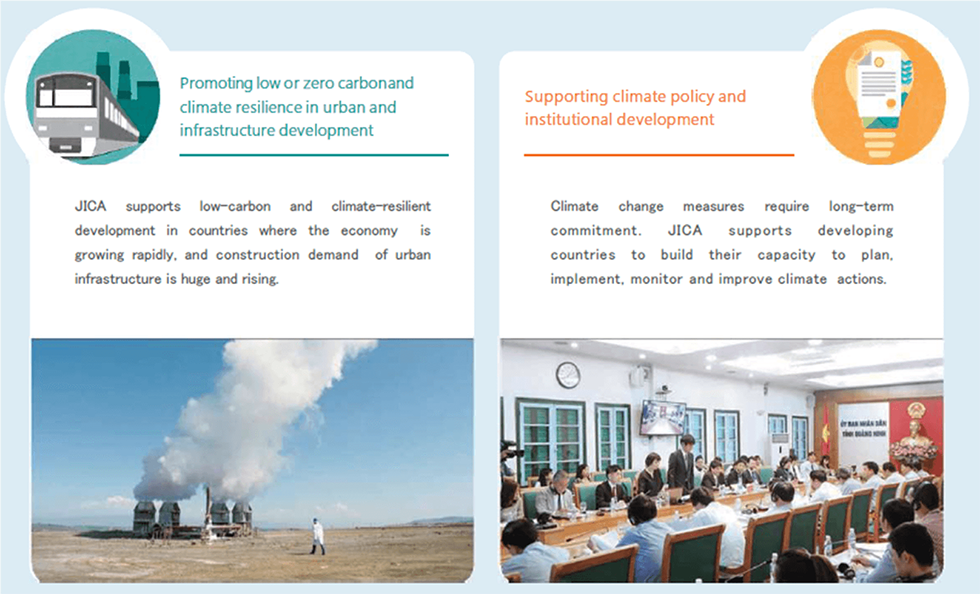
Priorities under the Global Agenda (zero-carbon and climate resilient urban and infrastructure development, Climate policy and institutional development)
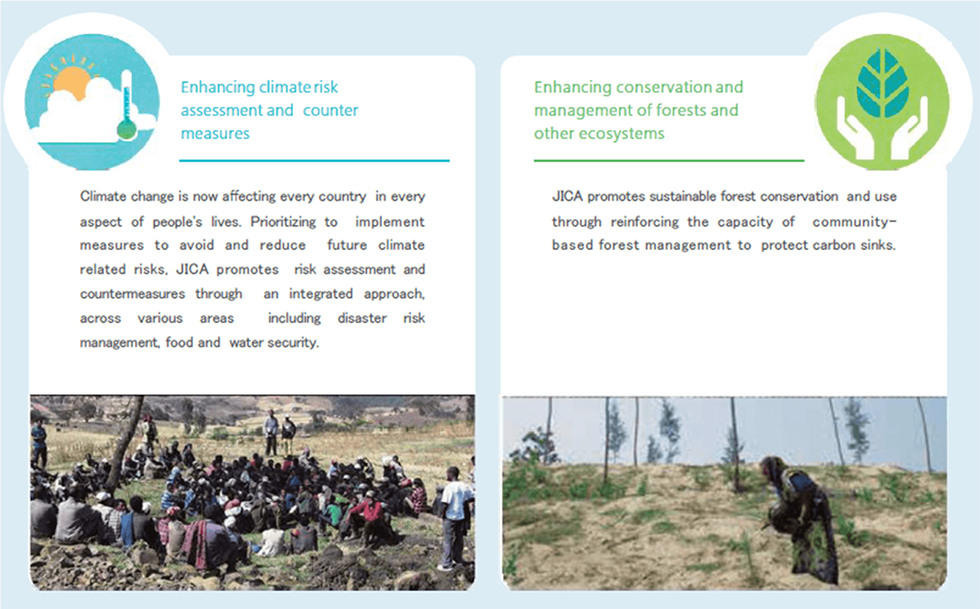
Priorities under the Global Agenda (Enhancing adaptation and risk financing based on climate risk assessment, Conservation and management of forests and other ecosystems)
JICA has over 100 offices in developing countries and provides Japan's ODA through technical cooperation, finance and investment, and grants. In June 2021, JICA developed “Global Agenda” as a strategy towards the zero-carbon and climate-resilient society with 2 pillars:
1.Enhance countries’ capacity for formulation and implementation of NDC, transparency framework and Long-term low emission development strategy for the Implementation of the Paris Agreement
2. Promote co-benefits of achieving the SDGs and taking climate actions such as:
- Zero-carbon and climate-resilient urban and infrastructure development
- Enhancing adaptation and risk financing based on climate risk assessment
- Conservation and management of forests and other ecosystems for GHG emission reduction and carbon sinks
Display the document


Carbon Negative Concrete "CO²-SUICOM"
"CO²-SUICOM" is a technology that absorbs and permanently stores carbon dioxide during the hardening process of concrete.
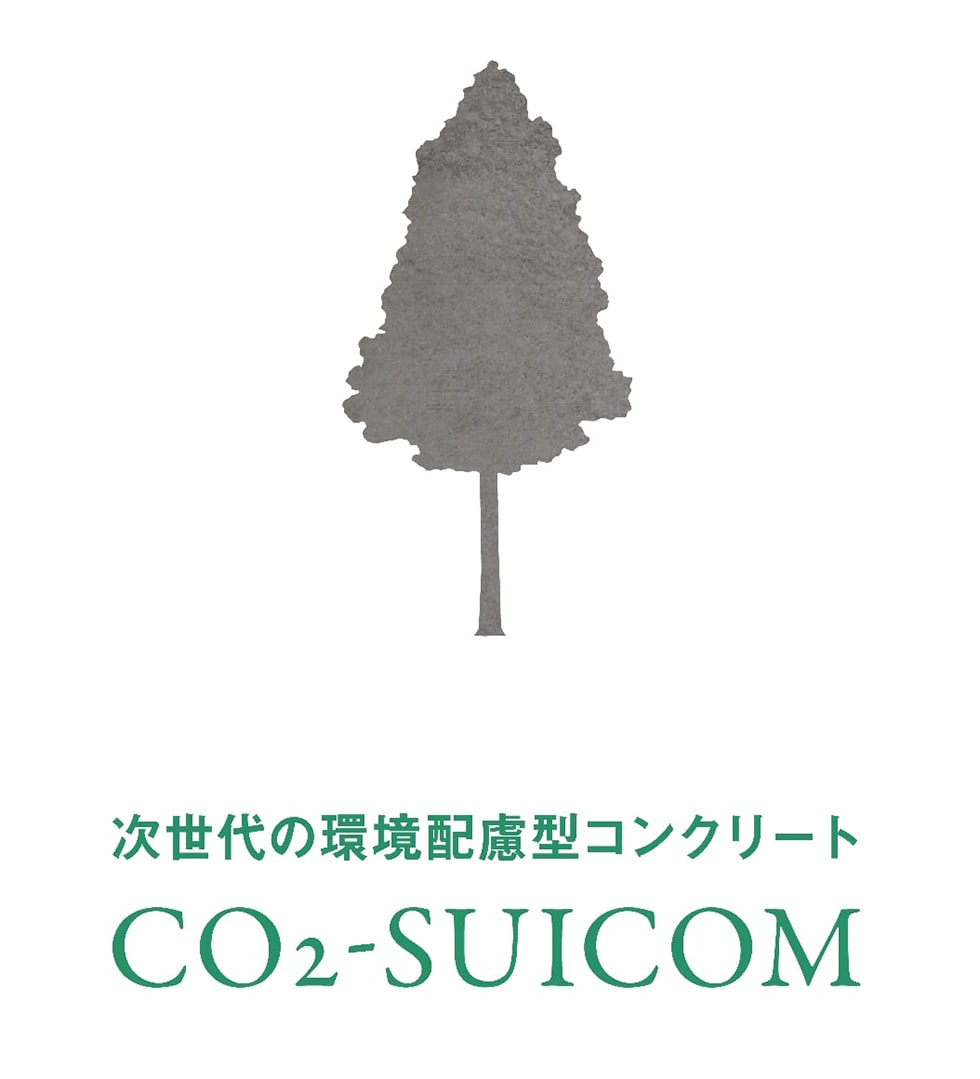
CO²-SUICOM is a technology that can contribute to the reduction of CO² emissions of more than about 300 kg/m³ during the production of concrete.CO²-SUICOM can (1) drastically reduce CO² emissions during cement production by replacing more than half of the cement with special admixtures made from industrial waste or other raw materials with zero CO² emissions (reduction: approx. 200 kg/m³), and (2) a large amount of CO² is absorbed and fixed in the concrete by curing the concrte in a highly concentrated CO² environment (absorption amount: approx. 100 kg/m³). According to various research organizations (McKinsey, etc.), concrete absorption and fixation technology for minerals, including CO²-SUICOM, is expected to contribute to the reduction of billions of tons of CO² by 2030, which has the potential to exceed Japan's national emissions.
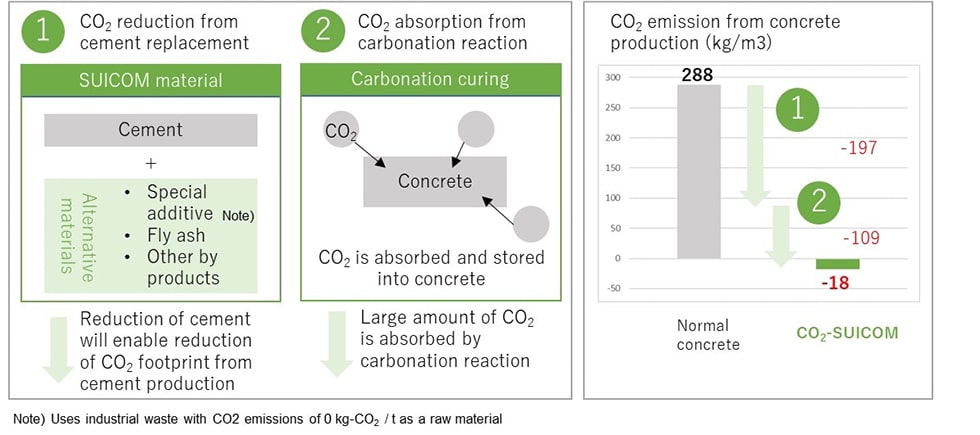
CO²-SUICOM is the world's first commercialized carbon negative concrete technology.
In Japan, it is already used for construction of highways and paved roads, etc., and we are now promoting commercialization overseas. In order to decarbonize our society, The Chugoku Electric Power Company, Kajima Corporation, Denka Corporation and Landes Corporation has developed the technology, and Mitsubishi Corporation is in charge of commercialization overseas.
A CO²-SUICOM concrete block can reduce CO² emissions equivalent to what a cedar tree can absorb in a year. This is a break thorugh technology for concrete which is one of the most consumed materials in the world.With the power of CO²-SUICOM we aim to realize a sustainalble society by decarbonizing the global infrastructure.
Display the document


Open Innovation through Co-creation between Seven & i and Business Partners
-Challenges to carbon neutrality and circular economy

Seven & i Group’s environmental declaration:『GREEN CHALLENGE 2050』
Under the GREEN CHALLENGE 2050 environmental declaration, we are working to reduce CO2 emissions from the Group's store operations by 50% by 2030 (compared to fiscal 2013) and to achieve virtually zero emissions by 2050.
Since it is difficult for Seven & i Group to achieve these targets alone, we are promoting initiatives through open innovation based on co-creation with our business partners.
The following is an introduction to two of these initiatives: (1) 100% renewable energy stores initiative using our original batteries made from recycled electric vehicle batteries, and (2) PET bottle collection and recycling initiative using collection machines that can be installed in convenience stores.
Display the document




